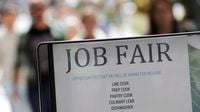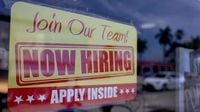It’s been a long, hot summer for the American job market—and as the first days of September 2025 roll in, the mood among workers and employers alike is shifting. The once-blazing labor market, which powered the post-pandemic economic recovery, is showing unmistakable signs of cooling. According to data released this week by the Bureau of Labor Statistics, nonfarm payrolls are projected to have increased by just 75,000 jobs in August, a slight uptick from July’s 73,000 but a far cry from the robust gains seen in previous years.
Private-sector hiring is losing steam, too. The ADP National Employment Report, cited by Reuters and Bloomberg, showed private employment grew by only 54,000 jobs last month, down sharply from July’s 106,000. This slowdown is more than just a blip: employment gains have averaged 35,000 per month over the past three months, compared to 123,000 during the same period in 2024, according to government reports. The unemployment rate, meanwhile, is expected to rise to 4.3% in August from 4.2% in July, reflecting a labor market that’s gradually slackening.
"We continue to see softness growing in the labor market as tariff policy uncertainty lingers, immigration changes take effect, and AI adoption grows," Eric Teal, chief investment officer at Comerica Wealth Management, told Reuters. He added, "The silver lining is the weaker the jobs data, the more cover there is for stimulative interest rate cuts that are on the horizon."
Initial claims for state unemployment benefits rose by 8,000 to a seasonally adjusted 237,000 for the week ended August 30, according to the Department of Labor. That figure came in higher than economists’ forecasts, which had predicted 230,000 claims. While layoffs remain relatively low—businesses are still somewhat reluctant to let workers go after struggling to hire during the pandemic—there’s a growing sense of caution. The number of people receiving unemployment benefits after the initial week slipped by 4,000 to 1.94 million during the week ending August 23, a sign that while layoffs are up, many are still holding on to jobs a bit longer than in previous downturns.
One sector feeling the squeeze is pharmaceuticals, where major layoffs have picked up pace in recent weeks. Job openings across the economy declined in July, but with only a slight increase in hiring, it’s clear that churn is replacing explosive growth. Small businesses, once desperate for staff, are now feeling less pinched—and more Americans are reporting that jobs are no longer as “plentiful” as they once seemed.
The Federal Reserve has kept its benchmark overnight interest rate in the 4.25%-4.50% range since December 2024, but the changing labor landscape is prompting speculation about a policy shift. Fed Chair Jerome Powell signaled last month that a rate cut could be on the table at the central bank’s September 16-17 meeting, acknowledging the risks posed by a softening job market. Still, Powell was quick to point out that inflation remains a threat, suggesting that the Fed is walking a tightrope between supporting employment and keeping prices in check.
Wage growth is also expected to slow, with forecasts pointing to a 3.8% increase in August. Steady work hours and less overtime are reinforcing the sense that the labor market is maturing, if not stalling. For many workers, that means fewer opportunities to pad their paychecks, and for consumers—who drive about 70% of U.S. economic output—less spending power.
Economists are quick to point out that the labor market’s cooling is not happening in a vacuum. President Donald Trump’s sweeping import tariffs and a crackdown on immigration have been cited as factors hampering hiring in industries like construction and restaurants. As Reuters reported, the government’s “Beige Book” noted that “firms were hesitant to hire workers because of weaker demand or uncertainty.” Businesses are also grappling with the rapid adoption of artificial intelligence, which is reshaping roles and possibly dampening demand for some types of workers.
Trade policy is adding another layer of uncertainty. The U.S. trade deficit widened dramatically in July, ballooning 32.5% to $78.3 billion, as reported by Reuters. This jump was driven by record inflows of capital and goods, with imports soaring 5.9% to $358.8 billion. Notably, capital goods imports hit a record $96.2 billion, but imports of pharmaceuticals and motor vehicles actually declined. The duties imposed by Trump’s administration have caused wild swings in imports and the trade deficit, muddying the waters for businesses trying to plan for the future. A U.S. appeals court recently ruled that most of Trump’s tariffs were illegal, adding yet more uncertainty for companies navigating global supply chains.
Exports, meanwhile, edged up just 0.3% to $280.5 billion. Gains in capital goods and non-monetary gold were offset by declines in finished metal shapes and travel services, the latter affected by the White House’s immigration policies. Imports of services, including transport and business services, reached a record $75.5 billion, while exports of services also hit a new high at $101.0 billion.
All this turbulence has real consequences for the broader economy. Goldman Sachs recently lowered its estimate for third-quarter GDP growth to 1.6% from 1.7%, citing the ongoing disruptions from tariffs and the persistent uncertainty facing firms. As Eugenio Aleman, chief economist at Raymond James, put it to Reuters: “Disruptions from tariffs are still making their rounds across the economy and increased uncertainty continues to be present in firms’ decision-making processes.”
The financial markets are watching all of this closely. Stocks on Wall Street have been trading higher, perhaps on the expectation that softer labor data will prompt the Fed to cut rates and support asset prices. The dollar has strengthened against a basket of currencies, while U.S. Treasury yields have fallen, reflecting investors’ cautious optimism that lower rates could be on the horizon.
For everyday Americans, the implications are clear. The days of easy job hopping and rapid wage gains may be behind us, at least for now. With job growth slowing, layoffs rising in some sectors, and uncertainty hanging over trade and immigration policy, workers and businesses alike are preparing for a slower, more unpredictable ride ahead. Whether the Federal Reserve’s next move will provide the jolt the economy needs remains to be seen, but one thing is certain: the U.S. labor market is at a turning point, and the coming months will be crucial in determining what comes next.


